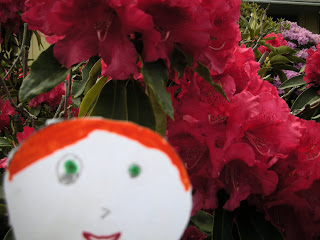


I will have fond memories of my stay here!





 From the ferry I could see large cranes that lift shipping containers off barges. They kind of look like something straight out of Star Wars!
From the ferry I could see large cranes that lift shipping containers off barges. They kind of look like something straight out of Star Wars!







 Grafton Street is one of the two principal shopping streets in Dublin city center, the other being Henry Street. It runs from St. Stephen's Green in the south to College Green in the north. The street was named after Henry FitzRoy, 1st Duke of Grafton, who owned land in the area. The street was developed from a then existing country lane by the Dawson family in 1708, after whom the parallel Dawson Street is named.
Grafton Street is one of the two principal shopping streets in Dublin city center, the other being Henry Street. It runs from St. Stephen's Green in the south to College Green in the north. The street was named after Henry FitzRoy, 1st Duke of Grafton, who owned land in the area. The street was developed from a then existing country lane by the Dawson family in 1708, after whom the parallel Dawson Street is named.

 O'Connell Street and alot of other interesting things.
O'Connell Street and alot of other interesting things.




 Tomorrow we fly home. I have had a great time visitng Ireland and I will be sad to leave.
Tomorrow we fly home. I have had a great time visitng Ireland and I will be sad to leave.
 St Stephen's Green is an inner-city public park within the city center. The park is rectangular, surrounded by streets that once formed major traffic arteries through Dublin city center.
St Stephen's Green is an inner-city public park within the city center. The park is rectangular, surrounded by streets that once formed major traffic arteries through Dublin city center. The grounds are roughly rectangular and are centred on a formal garden. One of the more unusual aspects of the park lies on the north west corner of this central area - a garden for the blind with scented plants, which can withstand handling, and are labelled in Braille.
The grounds are roughly rectangular and are centred on a formal garden. One of the more unusual aspects of the park lies on the north west corner of this central area - a garden for the blind with scented plants, which can withstand handling, and are labelled in Braille.

 The DART is a rapid transit system that runs up and down the coastline of Dublin Bay.
The DART is a rapid transit system that runs up and down the coastline of Dublin Bay. There are three sets of grinding stones in the Skerries watermill, powered by an overshot waterwheel. A large mill-pond controlled by a series of sluice-gates feeds the water to the mill. The four floors or lofts are served by two bag-hoists; winnowers and a blower are located above the stone floor and below the hoppers in the top loft.
There are three sets of grinding stones in the Skerries watermill, powered by an overshot waterwheel. A large mill-pond controlled by a series of sluice-gates feeds the water to the mill. The four floors or lofts are served by two bag-hoists; winnowers and a blower are located above the stone floor and below the hoppers in the top loft. 
 In 1191, under John Comyn, the first Anglo-Norman archbishop of Dublin, Saint Patrick's was raised to the status of a cathedral and the present building, the largest church in the country, was erected between 1200 and 1270. Over the centuries as the elements, religious reformation and persecution took their toll, the cathedral fell into serious disrepair, despite many attempts to restore it. Eventually between 1860 and 1900 a full-scale restoration based on the original design, was carried out by the Guinness family.
In 1191, under John Comyn, the first Anglo-Norman archbishop of Dublin, Saint Patrick's was raised to the status of a cathedral and the present building, the largest church in the country, was erected between 1200 and 1270. Over the centuries as the elements, religious reformation and persecution took their toll, the cathedral fell into serious disrepair, despite many attempts to restore it. Eventually between 1860 and 1900 a full-scale restoration based on the original design, was carried out by the Guinness family.

 Green ribbons and shamrocks were worn in celebration of St Patrick's Day as early as the 17th century, even though St. Patrick's Blue was the color traditionally associated with St. Patrick. He is said to have used the shamrock, a three-leaved plant, to explain the Holy Trinity to the pre-Christian Irish, and the wearing and display of shamrocks and shamrock-inspired designs have become a ubiquitous feature of the day. The phrase "the wearing of the green", meaning to wear a shamrock on one's clothing.
Green ribbons and shamrocks were worn in celebration of St Patrick's Day as early as the 17th century, even though St. Patrick's Blue was the color traditionally associated with St. Patrick. He is said to have used the shamrock, a three-leaved plant, to explain the Holy Trinity to the pre-Christian Irish, and the wearing and display of shamrocks and shamrock-inspired designs have become a ubiquitous feature of the day. The phrase "the wearing of the green", meaning to wear a shamrock on one's clothing.







